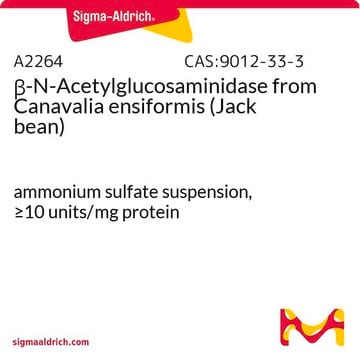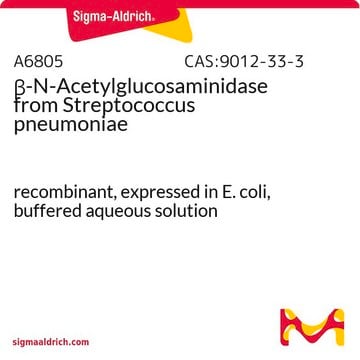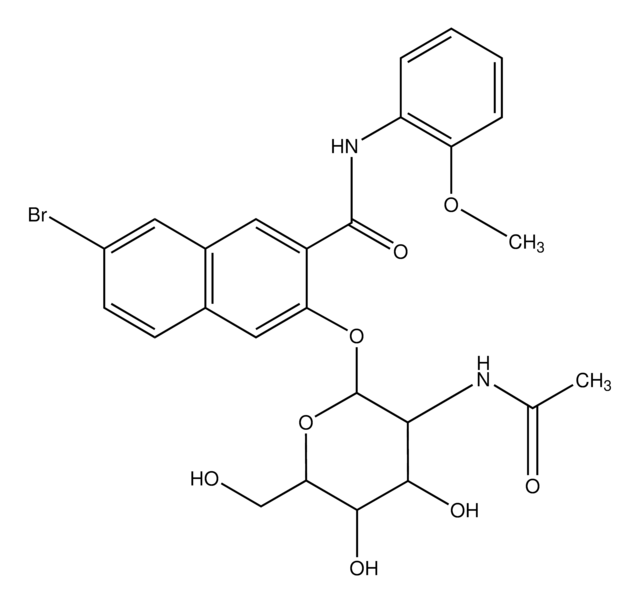推薦產品
形狀
solid
品質等級
用途
sufficient for ~50 tests
分子量
105.99 g/mol
製造商/商標名
Roche
技術
activity assay: suitable
顏色
white to light yellow-brown
溶解度
water: soluble ~210 g/L at 68 °F (Stop reagent)
soluble ~71 g/L at 32 °F (stop reagent)
water: soluble (Buffer substance, lyophilized substrate)
適合性
suitable for enzyme test
應用
life science and biopharma
儲存溫度
room temp
一般說明
N-acetyl-β-D-glucosaminidase (NAG) is mainly used in the colorimetric assay for the determination of N-acetyl-β-D-glucosaminidase in urine. NAG hydrolyzes 3-cresolsulfonphthaleinyl-N-acetyl-D-glucosaminide to release 3-cresolsulfonphthalein, which is measured photometrically at 580nm.[1] It is an intracellular lysosomal enzyme, present in the S3 segment of proximal tubular cells and distal nephron. Presence of NAG in the urine shows an organelle impairment in proximal tubule. Level of NAG rises in individuals over 70 years of age.[2]
應用
N-acetyl-β-D-glucosaminidase (NAG) has been used for preparing standards for the determination of N-acetyl-β-D-glucosaminidase in urine[1] in life-science research applications.
包裝
1 kit containing 3 components
準備報告
Working solution: Preparation of solutions:
Storage conditions (working solution): Stability of solutions:
Solution II is stable for 1 month when stored at 2 to 8 °C, protected from light.
Solution III is stable for 1 month stored at 2 to 8 °C.
Stability of the sample:
The activity determination of the N-acetyl-β-D-glucosaminidase (NAG) should be carried out directly after collecting the sample. Turbid urines should be centrifuged and the supernatant decanted. NAG is stable for one week at 2 to 8 °C and for one month when stored at -15 to -25 °C.
- Buffer solution
Dissolve the contents of bottle 1 with 55 ml double-distilledwater. - Substrate solution
Dissolve the contents of bottle 2 with 55 ml solution I. - Stop reagent
Dissolve the contents of bottle 3 with 110 ml double-distilled water.
Storage conditions (working solution): Stability of solutions:
Solution II is stable for 1 month when stored at 2 to 8 °C, protected from light.
Solution III is stable for 1 month stored at 2 to 8 °C.
Stability of the sample:
The activity determination of the N-acetyl-β-D-glucosaminidase (NAG) should be carried out directly after collecting the sample. Turbid urines should be centrifuged and the supernatant decanted. NAG is stable for one week at 2 to 8 °C and for one month when stored at -15 to -25 °C.
儲存和穩定性
Keep container tightly closed in a dry and well-ventilated place.
其他說明
For life science research only. Not for use in diagnostic procedures.
僅套裝組件
產品號碼
描述
- Buffer Substance consisting of citric acid and potassium citrate
- Lyophilized Substrate consisting of sodium 3-cresolsulfonphthaleinyl-N-acetyl-β-D-glucosaminide and borax
- Stop Reagent consisting of sodium carbonate
訊號詞
Danger
危險聲明
危險分類
Eye Irrit. 2 - Repr. 1B - STOT SE 3
標靶器官
Respiratory system
儲存類別代碼
6.1C - Combustible acute toxic Cat.3 / toxic compounds or compounds which causing chronic effects
水污染物質分類(WGK)
WGK 2
閃點(°F)
does not flash
閃點(°C)
does not flash
客戶也查看了
Anne-Sophie Truche et al.
Transplantation proceedings, 51(10), 3234-3243 (2019-11-17)
This study aimed to identify transplantation characteristics and biomarkers that predict outcomes for kidney transplant (KT) patients from donors after circulatory death (DCDs). Consecutive patients receiving a KT from a DCD in our center between 2014 and 2016 were included;
Clinical Nephrotoxins: Renal Injury from Drugs and Chemicals (2008)
Julia M Hofstra et al.
Nephrology, dialysis, transplantation : official publication of the European Dialysis and Transplant Association - European Renal Association, 23(8), 2546-2551 (2008-03-01)
An accurate prediction of prognosis in patients with idiopathic membranous nephropathy (iMN) would allow restriction of immunosuppressive treatment to patients who are at highest risk for end-stage renal disease (ESRD). Several markers of proximal tubular cell injury have been used
Maha Al-Asmakh et al.
Frontiers in pharmacology, 11, 569402-569402 (2021-02-26)
Chronic kidney disease (CKD) may be fatal for its victims and is an important long-term public health problem. The complicated medical procedures and diet restrictions to which patients with CKD are subjected alter the gut microbiome in an adverse manner
Raphael Allgaier et al.
Nephrology (Carlton, Vic.), 25(12), 888-896 (2020-08-26)
Chronic heart failure may lead to chronic kidney disease. Previous studies suggest tubular markers N-acetyl-b-D-glucosaminidase (NAG) and Kidney-injury-molecule-1 (KIM-1) as potential markers for the cardiorenal syndrome (CRS). The prognostic value of NAG and KIM-1 regarding implantable cardioverter defibrillator (ICD) shock
我們的科學家團隊在所有研究領域都有豐富的經驗,包括生命科學、材料科學、化學合成、色譜、分析等.
聯絡技術服務












